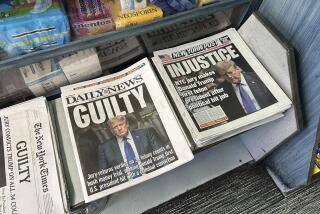Swimming With the Bottom Feeders : Media insider James Fallows turns a jaundiced eye on his colleagues : BREAKING THE NEWS: How the Media Undermine American Democracy,<i> By James Fallows (Pantheon Books: $23; 296 pp.)</i>
Twenty years ago, the film “All the Presidents Men” projected a sexy image of journalists uncovering scandal for the common good. At the pinnacle of their popularity, they were perceived as democracy’s champions, members of a fourth branch of government able to uphold the ideals that America’s three other branches seemed too sagging to support.
Since then, journalists have only stepped up their adversarial gait, looking more fervently than ever for corruption and impropriety. But to their surprise, no one is applauding anymore: Faced with steadily declining public approval ratings, journalists now find themselves accused of undermining the very democratic ideals we once praised them for championing.
In a 1995 Times Mirror study, a majority of Americans polled said the news media’s “negativism . . . gets in the way of society solving its problems.” And in this caustic attack on his own profession, James Fallows goes further:
“Step by step, mainstream journalism has fallen into the habit of portraying public life in America as a race to the bottom, in which one group of conniving, insincere politicians ceaselessly tries to outmaneuver another.”
Fallows was first struck by the gulf between the people and the press during the ’92 presidential campaign, when the questions citizens put to politicians in town halls and on talk shows differed tellingly from those posed by reporters:
“The citizens asked overwhelmingly about the what of politics. What are you going to do about the health care system? What can you do to reduce the cost of welfare? The reporters asked almost exclusively about the how. How are you going to try to take away Perot’s constituency? How do you answer charges that you have flip-flopped?”
The media’s constant preoccupation with who’s winning and who’s losing (Fallows calls it the “news-as-sports” model) is “as flattening and mind-shrinking as if the discussion of every new advance in medicine boiled down to speculation about whether its creator would win the Nobel Prize that year.”
Press-bashing is usually easy to discredit. When journalists are assailed from both left and right, it only makes them appear more neutral. When they are assaulted for being lowbrow (see Eric Burns’ “Broadcast Blues,” 1993, or Paul Weaver’s “News and the Culture of Lying,” 1994), it often makes their critics seem unrealistically highbrow.
Fallows cannot be dismissed so easily. A media insider--Washington editor of the Atlantic Monthly and a regular contributor to NPR and PBS--he is able to go beyond grousing and offer three plausible reasons why journalists would want to portray politics as just a game played by careerists when their very jobs depend on the public’s belief that it is meaningful to their lives.
Reason No. 1 is that it’s easier to analyze the politics of an issue than the issue itself: “Instead of talking about Bosnia, you can talk about whether Bob Dole will criticize Bill Clinton over Bosnia. Instead of talking about the real situation of Medicare, you can talk about whether the Republicans have gone too far in scaring old people about Medicare.”
Merely scoring a perceived political game, however, rarely generates useful insights. News analysts, Fallows shows, are usually wrong, both about people (only two days before the ’94 congressional elections, Fallows writes, “many of the country’s most admired analysts had no idea what was about to happen”) and about trends: “At the end of the Cold War, the world was flowering with hundreds of new democracies. A year or two later, the world was degenerating into hideous ethnic feuds. . . . One year, Americans are becoming body conscious and exercise mad. A year later, they’re fatter than ever before.”
Reason No. 2 is that these “news analysts” have become role models for the entire profession. While the news-as-sports model first emerged on TV news, top print journalists have come to acquire high-level sources and high-paying speaking gigs by virtue of their appearances on TV talk shows. (David Gergen, for instance, made $466,525 as a journalist in 1992.) To make it onto these shows--and Fallows writes from experience--one has to focus “more on what’s entertaining than on what’s useful.”
As one TV talk show producer coaches a reporter: “Don’t say, ‘the budget deficit stimulates the economy but also passes on a burden’; say, ‘It’s a great idea!’ or ‘It’s a terrible idea!’ ”
Reason No. 3 is that most editors of mainstream American newspapers are reluctant to endorse “public journalism,” a nascent movement to help people feel more connected to community and country, because they believe it would compromise objectivity.
Fallows successfully challenges this view by showing that public journalism is compatible with good journalism.
For instance, he cites the New Orleans Times-Picayune’s innovative reportage after David Duke was nearly elected governor of Louisiana in 1991. Rather than simply report what the most extreme white racists said about blacks and what the most publicity-seeking black nationalists said in turn, the paper assigned 20 reporters to examine the historic, economic and political roots of the city’s racial tensions.
Fallows, nevertheless, appears to have conflicted feelings about how fully objectivity should be embraced as a journalistic ideal.
On one page, he criticizes the American media for trying to “shoehorn” world events “into concepts that explain American domestic politics. . . . Most of what the American press reports about the world outside our borders has less to do with the daily realities of life in China or South Africa or Chile than with projections of American concerns, neuroses, and assumptions onto other parts of the world.”
On another page, however, he excoriates Mike Wallace for not taking the American side: On a PBS show about media ethics, Wallace is asked what he would do if, while traveling with an enemy patrol, he discovers that it is about to ambush American soldiers. Should he try to warn his compatriots? Fallows is contemptuous when Wallace answers “No. . . . You don’t have a . . . duty” higher than neutrality.
Just as Fallows doesn’t grapple with the question of whether our media can be both objective and American at the same time, so too does he fail to consider the related question of whether they can be simultaneously enlightening and entertaining. This has left him vulnerable to slack-jawed critics who wonder, “How can this guy think Americans are closet policy wonks, secretly hungering to read Congressional Quarterly, when we all know that ‘news-as-sports’ wins in the Nielsen ratings?”
These critics, however, are glibly implying that we are faced with only two stark options: news-as-sports or Congressional Quarterly. Let’s hope that the prevailing cynicism doesn’t lead us to rule out the possibility of a third option: concise but searching journalism that helps harried citizens understand, as Fallows puts it, “what can be changed and what must be endured.”
More to Read
Sign up for our Book Club newsletter
Get the latest news, events and more from the Los Angeles Times Book Club, and help us get L.A. reading and talking.
You may occasionally receive promotional content from the Los Angeles Times.






